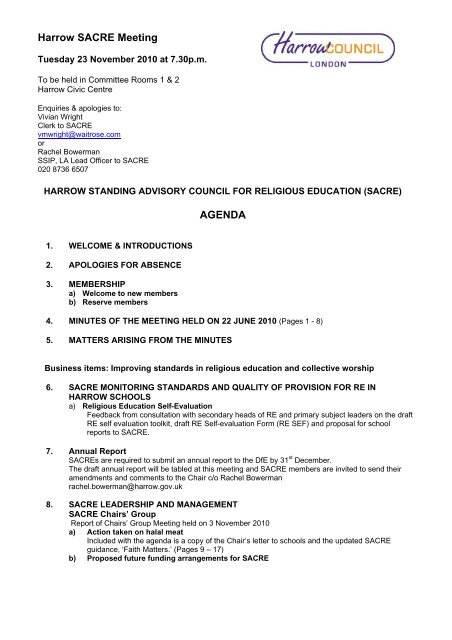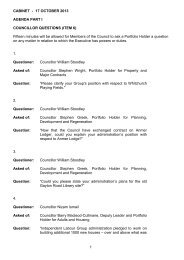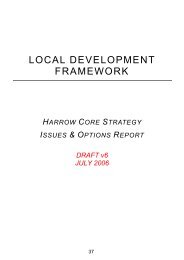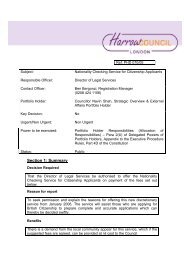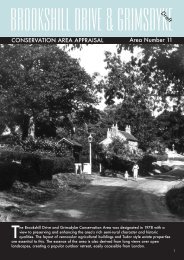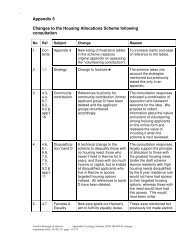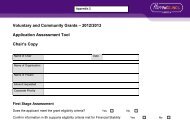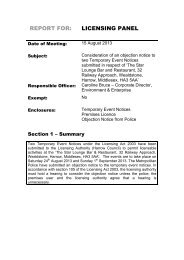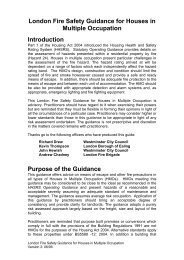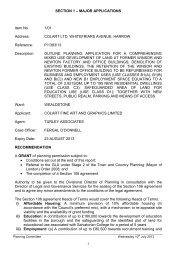Apologies for Absence: PDF 239 KB - Harrow Council
Apologies for Absence: PDF 239 KB - Harrow Council
Apologies for Absence: PDF 239 KB - Harrow Council
Create successful ePaper yourself
Turn your PDF publications into a flip-book with our unique Google optimized e-Paper software.
<strong>Harrow</strong> SACRE MeetingTuesday 23 November 2010 at 7.30p.m.To be held in Committee Rooms 1 & 2<strong>Harrow</strong> Civic CentreEnquiries & apologies to:Vivian WrightClerk to SACREvmwright@waitrose.comorRachel BowermanSSIP, LA Lead Officer to SACRE020 8736 6507HARROW STANDING ADVISORY COUNCIL FOR RELIGIOUS EDUCATION (SACRE)AGENDA1. WELCOME & INTRODUCTIONS2. APOLOGIES FOR ABSENCE3. MEMBERSHIPa) Welcome to new membersb) Reserve members4. MINUTES OF THE MEETING HELD ON 22 JUNE 2010 (Pages 1 - 8)5. MATTERS ARISING FROM THE MINUTESBusiness items: Improving standards in religious education and collective worship6. SACRE MONITORING STANDARDS AND QUALITY OF PROVISION FOR RE INHARROW SCHOOLSa) Religious Education Self-EvaluationFeedback from consultation with secondary heads of RE and primary subject leaders on the draftRE self evaluation toolkit, draft RE Self-evaluation Form (RE SEF) and proposal <strong>for</strong> schoolreports to SACRE.7. Annual ReportSACREs are required to submit an annual report to the DfE by 31 st December.The draft annual report will be tabled at this meeting and SACRE members are invited to send theiramendments and comments to the Chair c/o Rachel Bowermanrachel.bowerman@harrow.gov.uk8. SACRE LEADERSHIP AND MANAGEMENTSACRE Chairs’ GroupReport of Chairs’ Group Meeting held on 3 November 2010a) Action taken on halal meatIncluded with the agenda is a copy of the Chair’s letter to schools and the updated SACREguidance, ‘Faith Matters.’ (Pages 9 – 17)b) Proposed future funding arrangements <strong>for</strong> SACRE
9. NATIONAL RE MONTH (MARCH 2011An update on the proposed <strong>Harrow</strong> contribution to National RE Month (Double sided colour flyer)In<strong>for</strong>mation items: improving SACRE’s effectiveness10. REPORTS FROM SACRE PARTNERSa) <strong>Harrow</strong> Inter Faith <strong>Council</strong>Including ’The Role of Religion in Society’ question and answer session with contributions from<strong>Harrow</strong> secondary schoolsb) Faith communitiesc) <strong>Harrow</strong> Hate Crime Forum11. DATES OF FUTURE SACRE MEETINGSThe date published in the corporate calendar is Wednesday 2 nd March 2011.
HARROW SACRE(STANDING ADVISORY COUNCIL FOR RELIGIOUS EDUCATION)MINUTES OF THE MEETING ON 22 JUNE 2010Attendance:Group A: (Religious traditions and Christian Churches)~ Mr Zia BaigA <strong>Council</strong>lor Asad OmarA Mrs Martha Besser (Vice Chair)~ Miss Fatema Rahemani* Mr Mike Bishop* Mr Neville Ransley* Dr Julie Crow* Mrs Gill RossA Mrs Niru Desai* Mrs Doreen Samuels* Mrs Phiroza Gan-Kotwal~ Mr Paramjit Singh-Kohli* Mr Vijay HiraniA Ven Sumana Sramaner~ Dr Vinod KapashiA Ms Beverley WilsonGroup B: (Church of England)A Mrs Mary Abbott* Rev’d. Giles PinnockGroup C: (Teachers’ Associations)A Ms Heena ModiA Ms Bhavita Pandya* Ms Nancy ParsonsGroup D: (Local Authority)<strong>Council</strong>lors:A Nana Asante (Sasi Suresh reserving)~ Lurline Champagnie*Bill Philips (Reserve)Co-opted MembersSeconded from the <strong>Harrow</strong> Student AdvisoryBoard: vacanciesAlso attending:* Ms Rachel Bowerman (Senior SchoolImprovement Professional & Adviser to SACRE,nominated by the Director of Education)* Vivian Wright (Clerk to SACRE)Visitor from Stag Lane Middle School:Alexis Sobbel, RE CoordinatorA Rev’d. Matthew Stone~ Mrs Manju Radia* Mrs Alison Stowe (Chair)* Camilla Barth*Nizam Ismail* denotes presenceA denotes absence with apologies~ denotes absence without apologies1. Welcome and IntroductionsThe Chair welcomed everyone to the meeting, especially Alexis Sobbel from Stag Lane MiddleSchool, who was attending in order to make a presentation about her school’s SEF (SelfEvaluation Form)2. <strong>Apologies</strong> <strong>for</strong> <strong>Absence</strong>:RESOLVED: To note apologies <strong>for</strong> absence from Mrs Martha Besser, Mrs Niru Desai, VenSumana Sramaner, Mrs Beverley Wilson, Cllr Asad Omar, Mrs Mary Abbott, Rev’d MatthewStone, Ms Heena Modi, Cllr Nana Asante and Mrs Bhavita PandyaThe following members were absent without apologies: Mr Zia Baig, Miss Fatema Rahemani,Mrs Manju Radia and Cllr Lurline Champagnie,<strong>Harrow</strong> SACRE Minutes 22/06/10 1
3. Membership:Cllr Sasi Suresh was reserving <strong>for</strong> Cllr Nana Asante.Cllr Camilla Barth and Cllr Nizam Ismail have joined the committeeCllr Bill Philips was attending as a reserveMr Shabban Saddik has resigned from the committeeAnjana Patel is no longer on the committee as she is no longer a councillorIt was agreed that the committee should seek to reinstate the student representatives, perhapsseeking students from the schools who were already working with the committee. The Chairwould take this <strong>for</strong>ward. Action Chair.The committee recorded its congratulations to Cllr Asad Omar who is now Mayor of <strong>Harrow</strong>.Some concerns were expressed that this meeting was not on the council calendar. The Clerk willliaise with Mark Doherty at the Civic Centre to ensure that future meetings are recorded.Action: Clerk.Mrs Phiroza Gan-Kotwal expressed concern at the high number of absences at the last meeting.There was some discussion as to whether members who frequently missed meetings shouldcontinue as members of the committee. It was agreed that the Chairs Committee should lookinto this and report back to the full committee. Action: Chairs Committee4. Election of Chair and Vice-ChairNo nominations had been received prior to the meetingDoreen Samuels, seconded by Camilla Barth proposed Alison Stowe as Chair.Elected unanimouslyCllr Nizam Ismail seconded by Nancy Parsons proposed Camilla Barth as Vice-Chair.Elected unanimously5. Order of the AgendaIt was agreed to take item 7 first so that Alexis Sobell could then leave the meeting. However, <strong>for</strong>clarity, the minutes follow the original order of the agenda.6. Minutes of the Meeting held on 9 March 2010: (previously circulated)RESOLVED: That the minutes of the meeting held on 9 March 2010, having been circulatedand taken as read, were signed as a correct record7. Matters arising from the minutes not included elsewhere on the agenda:5. Matters arising from the minutesWebsite: very little progress has been made on the website6. SACRE Monitoring Standards and Quality of provision <strong>for</strong> RE in <strong>Harrow</strong> Schoolsa) Philosophy and Ethics review reportNancy Parsons, who had not been present at the last meeting, expressed concern that RE atA Level was being rebranded and “philosophy and ethics”. Rachel Bowerman welcomed thiscomment and drew the committee’s attention to p4 of the minutes (vi. Curriculum) where shehas made exactly this point. It is important that RE is promoted and shown to relevant tothose who do not hold religious beliefs and taught in a way that makes it popular withstudents, interactive and exciting.<strong>Harrow</strong> SACRE Minutes 22/06/10 2
8. Determinations: Rachel Bowerman has written to Vaughan First and Middle Schoolconfirming its determination. She has also written to those schools that had been advised byPat Stevens that they needed to renew their determinations, to in<strong>for</strong>m them that no action wasrequired, they should continue as they are and await new guidance from SACRE.10. Any Other business:a) Park High Visitors: the Chair had written a letter of thanks to the Park High visitors <strong>for</strong>their presentation.Business Items: Improving standards in religious education and collectiveworship8. SACRE Monitoring Standards and Quality of Provision <strong>for</strong> RE in <strong>Harrow</strong> SchoolsRachel Bowerman introduced this item explaining that this is the sort of presentation that enablesSACRE to fulfil its duties to monitor the quality of RE. The report from Park High School in theSpring Term had been very in<strong>for</strong>mative and successful. The Committee had agreed to developthis process through consultation with schools and to invite school representatives to SACREmeetings wherever possible. This evening, Alexis Sobbel from Stag Lane Middle School wasgoing to report using the school RE SEF. Rachel Bowerman explained that this document was, ineffect, a confidential document. The Committee was privileged to share this report. She asked thecommittee to respect this confidentiality. Normally such a document would come to the Chairsgroup who would summarise it <strong>for</strong> the committee. As this was the first time the RE SEF had beenused, Alison Sobell was attending the meeting to report to the full committee.At this point (7.50pm) Phiroza Gan-Kotwal arrived.a) Stag Lane Middle School RE Self Evaluations Form (RE SEF) (tabled at the meeting)The SEF is arranged under the headings used <strong>for</strong> the general school SEF. Alexis Sobbel explainedthe process by which the teaching of RE was evaluated. Books of pupils in years 4,5,6 and 7 werescrutinized, and lessons were observed in these year groups. The children’s work was evaluated inrelation to RE level descriptors to see if they are reaching appropriate targets. There was also ameeting with children from different year groups. This element of discussion makes an importantcontribution to the evaluation process.She took the committee through the RE SEF, drawing attention to the following.Pupils’ achievement in RE and the extent to which they enjoy learning in REPupils’ achievement in RE was judged to be good.An area <strong>for</strong> development was pupils’ written work where their attainment was not as high as in coresubjects.Pupils’ behaviour in REPupils’ behaviour in RE was outstanding. They demonstrated enthusiasm and thoroughly enjoyed thesubject.Every Child Matters and REChildren were com<strong>for</strong>table to talk about their beliefs and showed themselves to be confident learners.The extent to which, through RE, pupils contribute to the school and wider communityParent ambassadors and the Rev’d Matthew take part in assemblies. The children also visit differentplaces of worship.The extent of pupils’ spiritual, moral, social and cultural development in REThe children demonstrated tolerance and understanding of different religious viewpoints.<strong>Harrow</strong> SACRE Minutes 22/06/10 3
The quality of teaching in RETeachers enjoy teaching RE.The extent to which the RE Curriculum delivers the requirements of the Agreed Syllabus andmeets pupils’ needsThe school uses a combination of the old and new schemes of work and this delivers the requirementsof the Agreed Syllabus.The effectiveness of leadership and management in driving improvementVarious initiatives have been set up and these have contributed to the success and popularity of RE inthe school.The leadership and management of RE teaching and learningRE enjoys the full support of the Head Teacher and senior management team and this is a crucialfactor in its success.The effectiveness of partnerships in promoting learning and well-being in REAs mentioned above, the parent ambassadors have played a crucial role in improving the status ofRE. In response to a question from Cllr Camilla Barth, Alexis Sobbel reported that no children hadbeen withdrawn from RE classes and there had been no complaints or objections from parents whodid not wish their children to learn about other faiths.The effectiveness with which RE promotes equal opportunity and tackles discriminationAll pupils feel valued and demonstrate understanding and tolerance towards others.The effectiveness with which RE promotes community cohesionRE is seen to be very effective at promoting community cohesion.Overall effectiveness: how good is RERE teaching and learning is characterized by enthusiasm on the part of pupils and teachers. It is seento promote a climate where pupils feel valued and confident about expressing their beliefs. They alsodemonstrate understanding towards others.Important actions <strong>for</strong> REThe SIP outlines areas <strong>for</strong> development. These include using level descriptors to plan work moreeffectively and sharing good practice in RE teaching.Rachel Bowerman reminded the committee that Stag Lane Middle School has been judgedoutstanding in its most recent Ofsted inspection. She stressed the importance of triangulatingevidence by interviewing pupils, pointing out that RE is a subject where pupils often do better indiscussion than in written work. This is especially true of schools where there is a high percentage ofpupils with EAL. RE is relevant to their backgrounds and personal experience – it is an area wherethey are experts. The importance of RE is recognized in school and in society as a whole. RE is wherepupils learn respect <strong>for</strong> others’ beliefs and the subject also helps them to understand their own beliefsbetter. Conferring with pupils is an important element in this process.Rachel Bowerman also commented on the outstanding behaviour of pupils in RE, attributing this to thefact that children value what they are talking about. This is an important contribution to CommunityCohesion. It also demonstrates that teachers have created a safe and trusting environment.Rachel Bowerman validated the conclusions reached in the report. These included the need to maketeaching more open ended and to used the level descriptors of the Agreed Syllabus to help teachersmake judgments about what children know and understand.<strong>Harrow</strong> SACRE Minutes 22/06/10 4
Rachel Bowerman reflected that RE includes a considerable element of retelling of stories fromvarious religious traditions and this, in itself, is not a high level activity. To achieve a higher levelrequires pupils to explore the significance of these stories <strong>for</strong> believers. There is a need to adapt tasksso that children can demonstrate understanding in writing as well as in speaking and listening.Alexis Sobbel then described how standards in RE have been raised in the school. Measuresintroduced include the following:Working with gifted and talented children in REUsing more interactive methods of teaching which are popular with childrenTwo “RE days” pairing up year groups. One day looked at “Signs and symbols”, the other focused on“Festivals”Subsequently the children presented their work in assemblies and this revealed that they had learnt atremendous amount. Feedback was very positive.Alexis Sobbel also considered the pros and cons of using the SEF <strong>for</strong>m. It gave her knowledge of howto do a SEF, criteria <strong>for</strong> scrutinizing RE work and insight into level descriptors. It enabled her toidentify strengths in the school and areas <strong>for</strong> development and to provide an agenda to move <strong>for</strong>wardwith RE teaching. All this showed it was very useful: on the down side, it was a lot of work.Alexis Sobbel and Rachel Bowerman invited questions on the report:In response to a question from Cllr Nizam Ismail, Alexis Sobell said that the SEF <strong>for</strong>m could beapplied to other schools. Rachel Bowerman expressed the hope that this structure could be used byall schools. Using the RE SEF is not compulsory, but schools might consider it a valuable exercise.She stressed that support from senior leadership, as is the case at Stag Lane, is a crucial factor.In response to a question from a humanist representative, Alexis Sobell was able to reassure her thatchildren learn not only to respect other religions, but also to respect the beliefs and values of otherseven when they are not affiliated to a religion. It was agreed that this point should be included in theSEF.In response to a question from a non-con<strong>for</strong>mist Christian representative as to whether she would likeany changes to be made to the <strong>for</strong>m, Rachel Bowerman explained that the <strong>for</strong>m follows the SEFheadings. Alexis Sobbel added that in some cases it is difficult to distinguish the categories identified,e.g. between the effectiveness of partnerships and the promotion of Community Cohesion. Furthertraining in this area would be helpful.With the new government, it is highly likely that there will be further changes to the evaluationschedule, so it would be better to wait <strong>for</strong> these be<strong>for</strong>e making further changes.Rachel Bowerman in<strong>for</strong>med the committee that more details are now becoming available about a RESEF that is being trialled. This is on line and the in<strong>for</strong>mation gained will become part of a nationaldatabase. This is a different outcome altogether from the SEF that is internal to the school.A representative from the Jewish faith spoke of the importance of accountability, but also ofunderstanding context.In response to a question from a representative of the Teachers’ Associations, Rachel Bowermanin<strong>for</strong>med the committee that the RE SEF would not be required annually. It would go out on a rollingprogramme and once introduced would be updated as changes occurred.Cllr Camilla Barth asked about SACRE’s relationship with the proposed academies: RachelBowerman deferred this question to later in the meeting.Rachel Bowerman and the Chair warmly thanked Alexis Sobbel <strong>for</strong> her excellent and in<strong>for</strong>mativepresentation. Alexis Sobbel then left the meeting.Rachel Bowerman will write a letter of thanks. Action: Rachel Bowerman<strong>Harrow</strong> SACRE Minutes 22/06/10 5
) Consultation on SACRE’s draft RE SEFRachel Bowerman is taking this <strong>for</strong>ward with meetings with Secondary Heads of departments on 20July and with Primary Subject leaders in the autumn term.10. HMI Report: Trans<strong>for</strong>ming Religious Education (previously circulated)Rachel Bowerman introduced this item, explaining that the report describes the findings of a surveycarried out in a small sample of schools. The context is thematic rather than evaluative. The focus ison the creative curriculum, so this emerges as a theme. This report is based on inspections carried outbetween 2006-09 in 183 schools across 70 authorities.Key findings: primary schools showed a slight improvement, but not enough outstanding grades.Secondary schools were generally not as good: there were more inadequate schools. A contributivefactor may have been the impact of recent changes to the curriculum, making greater links betweensubjects resulting in less specific RE teaching.Secondary schools demonstrate success in the numbers of pupils entering <strong>for</strong> GCSE especially <strong>for</strong>short courses.Final Recommendations (p13)Strength of Community Cohesion was an outcome <strong>for</strong> RE in most schools.SMSC (Spiritual, Moral, Social and Cultural) development was also an important consequence of REteaching. Although moral, social and cultural elements were taught strongly, the spiritual element wasusually weaker.The report recommended a review of statutory arrangements <strong>for</strong> the delivery of a local curriculum <strong>for</strong>REAt this point (8.45) Cllr Bill Philips arrivedRachel Bowerman expressed doubts that a National Curriculum <strong>for</strong> RE teaching would improve REteaching. In her view, more resources spent on training teachers, creates greater improvement. Thisreport was written under the previous government and may not galvanise activity as its authors mayhave hoped.A representative of the Teachers Associations reflected that RE is the subject with the shortest supplyof specialist teachers. Cllr Camilla Barth questioned the relevance of the document in that no innerLondon schools were included. In outer London, only five schools were included and they were fromthe secondary sector.However, it was felt that the committee could use the report as a tool to convince the new governmentof the importance of RE especially in the context of personal Development and Community Cohesion.It would be possible to build on what was good in the report and push hard to get it noticed and toattract as much funding as it deserves. It was felt that the report surveyed a sufficient number ofschools to give a flavour of what is happening with RE. It could be a useful document <strong>for</strong> identifyinggood practice and <strong>for</strong> making recommendations. Those writing the report had outcomes in mind sotheir examples of good practice might be reflective of those desired outcomes.It was felt that the last three bullet points on p15 could well go on SACRE’s agenda. This would enableSACRE to consider what it is doing to establish these three recommendations. Rachel Bowermanwelcomed suggestions. These recommendations also linked to item 9 on the agenda and to CllrCamilla Barth’s earlier question about SACRE’s connection with academies.It was suggested that SACRE should write to the DfE to draw attention to this report and ask them tomaintain the high profile of RE. <strong>Harrow</strong> SACRE is a strong organisation with wide representation andthere<strong>for</strong>e it is in a good position to justify the importance of RE. Copies of the letter should be sent toOfsted and NASACRE. It was important to be proactive.It was noted that there should have been a recommendation as to whether the RE curriculum shouldbe agreed locally or national: it would be worth commenting on this in the letter. Rachel Bowerman<strong>Harrow</strong> SACRE Minutes 22/06/10 6
expressed the view that a locally agreed syllabus offers a unique experience that does not exist inother areas, and, what better vehicle could there be <strong>for</strong> community cohesion?Should SACRE also be commenting on teacher training and the need <strong>for</strong> more teachers? There are anumber of issues that SACRE members should be asking about focussing their enquiries on whatgoes on in schools. For example, TAs are being used more and more and SACRE needs to know ifthis is happening in <strong>Harrow</strong>.Rachel Bowerman will be raising the issues identified in this report at her meetings with primarysubject leaders and secondary Heads of departments.11. SACRE’s partnership with the Local Authority to raise achievement in Religious Education.The uncertainty of the present political climate posed question marks over the future of nationalstrategies. The QCDA could either disappear or have a lower profile. In addition there was the highprofile proposal <strong>for</strong> the setting up of academies.These changes make a difference to what can be provided. Rachel Bowerman cited an example of acourse, earlier this term, which was attended by subject leaders, but had no one to lead it. Thelandscape is changing. The LA may have to limit its School Improvement provision <strong>for</strong> schoolsneeding help and may no longer be able to provide the advisory team. The LA will not be able to offerthe kind of support available in the past.With regard to academies, we do not yet know how many schools will become academies. Academiesdo not have to use the locally agreed syllabus. There will be statutory requirements regarding RE but itis not known what they will be. This will shrink SACRE’s role as well as the LA’s. SACRE will need toconsider what it can do to enable schools to find the support they need. Teachers need subjectknowledge and confidence that can only be built up over time.It was proposed that the Chairs group prepare a bid to the <strong>Council</strong> <strong>for</strong> funding <strong>for</strong> core training <strong>for</strong>schools. This will need to be done <strong>for</strong> the Autumn Term. Although it is a time of cuts, there is a highrespect <strong>for</strong> SACRE. Another suggestion was made that faith communities might be approached <strong>for</strong>funding. The Chairs group will take this proposal <strong>for</strong>ward and consider the various suggestions made.Action: Chairs groupIn<strong>for</strong>mation items: improving SACRE’s effectiveness12. Celebrating RE month – March 2011March 2011 has been designated as RE month – this is a national event to publicise and raise thestatus of RE.After some discussion of what SACRE might contribute to this, it was suggested that the committeeshould offer some training opportunities <strong>for</strong> teachers in the <strong>for</strong>m of visits to places of worship such asthe new central mosque in <strong>Harrow</strong>, the new Hindu temple in Alperton, the Krishna Avanti school inStanmore and the Jewish Museum in Camden town.It was also felt that some Christian places of worship should be included.Any suggestions should be sent to the ClerkSACRE could compile a leaflet detailing events taking place in <strong>Harrow</strong>.14. Reports from SACRE Partnersa) <strong>Harrow</strong> Inter Faith <strong>Council</strong>: Martha Besser was not present to report to the committeeb) Faith Communities St Mary’s Church: garden party July 8 Sponsored floral arrangements: Gill Ross reported that her synagogue and<strong>Harrow</strong> <strong>Council</strong> have collaborated to provide floral arrangements along HatchEnd Broadway. Local traders have been given watering cans. The synagogue<strong>Harrow</strong> SACRE Minutes 22/06/10 7
also has a new part time rabbi who visits from Israel and conducts educationalsessions on Skype.International Humanist Day: Julie Crow in<strong>for</strong>med the meeting thatInternational Humanist Day was celebrated yesterday. The whole of this weekis International Humanist Week and the local humanists will be hosting a stallat the Zoom Leisure Centre next Sunday <strong>for</strong> the “Under one sky” festival. Itwas thought that perhaps SACRE should consider taking a stall another year.Westminster Interfaith Pilgrimage will visit various places of worship withspecial emphasis on the Synagogue in New George Street.c) <strong>Harrow</strong> Hate Crime ForumThe Chair has received no communications from the <strong>Harrow</strong> Hate Crime Forum.15. Any Other Businessa) Chairs group meeting: Rachel Bowerman will circulate some possible dates.Items <strong>for</strong> the Chairs group agenda:RE SEFsAction Plan arising from the HMI reportBid <strong>for</strong> funding from the councilMembership of the committee: recruitment and maintaining good attendanceIt was felt that it would be useful if other members of the committee could contactmembers of the chairs’ group by email. The two members of the chairs grouppresent at the meeting had no objection to sharing their email addresses:Gill Ross: gfross@btinternet.comMike Bishop: mikebishop@talktalk.netOther members of the Chairs group would be asked if they would allow theiremails to be available to members of SACRE.b) A Life to the world: Mrs Phiroza Gan-Kotwal circulated some books <strong>for</strong> students at differentstages. She invited the committee to examine these. They are resources <strong>for</strong> PHSE which hadcome to her attention at a Family Values meeting.11. Dates of Future SACRE MeetingsAutumn Term 2010:Wednesday 15 SeptemberTuesday 23 NovemberThe Meeting closed at 9.30pmSigned: (Chair) (Date)<strong>Harrow</strong> SACRE Minutes 22/06/10 8
HARROW STANDING ADVISORY COUNCIL FOR RELIGIOUS EDUCATIONHARROW SACRE8 th November 2010Dear Head TeacherDuring the summer term it became apparent that some schools which were providing hotmeals at lunchtime were unaware that all the meat provided by their third party catererswas halal. The resultant press coverage has caused some distress to non-Muslim faithgroups.As I know you are aware, <strong>Harrow</strong> is the most religiously diverse education authority in thecountry so it is clearly important to be mindful of the impact of all our decisions on faithgroups.The responsibility <strong>for</strong> provision of school meals lies with the Head Teacher andgovernors, and SACRE thought it would be helpful to reissue guidance that we publishedin 2009 about the dietary requirements of the religious groups in the borough to supportyou when selecting menus <strong>for</strong> your children.If you have further concerns or would like clarification on any issues, please do nothesitate to contact me.Yours sincerelyAlison Stowe Chair of <strong>Harrow</strong> SACRE9Alison Stowe, Chair of SACRE, c/o Teachers’ Centre, Tudor Road, Wealdstone, Middlesex, HA3 5PQ
Faith Matters in<strong>Harrow</strong>:Guidance onSensitivities thatImpact onSchools
Faith Matters in <strong>Harrow</strong>:Guidance on the sensitivities that impact on schools.The London Borough of <strong>Harrow</strong> has the greatest diversity of faiths in thecountry. Indeed, there are meeting places <strong>for</strong> all the major faiths in theborough. This document aims to help teachers be aware of the practicesof the various faiths and how these impact on our children as they engagewith the National Curriculum.The law states that children may be withdrawn from sex education andcollective worship and R.E. but are expected to attend all other lessons. Itis important to understand that in some aspects of the NationalCurriculum children may be in a position where they are asked toparticipate in activities that the faith of their parents tells them isoffensive. This can be very unsettling <strong>for</strong> the child.This document aims to help staff recognise and respect differences in ourmulti-faith schools. It is also an attempt to acknowledge the dialogue wehave in SACRE with our many faith groups in the hope that children inour schools feel confident that their faith will be respected and valued.The dialogue <strong>for</strong> this document began at a working party at <strong>Harrow</strong><strong>Council</strong> offices on September 20 2007 when members of nearly all ourfaiths came together to discuss how their faith impacts with areas of theNational Curriculum. The following topics were discussed:Dress,Diet,Jewellery,Music,Art,Dance/P.E.,Sex education,Science,Drama,Holy Books.10
We were all conscious that there are a variety of opinions from within afaith group about each subject, but this paper has been checked by at leastone member of the faith group represented on <strong>Harrow</strong> SACRE.Particular thanks to the following who attended the working party andmany others who have made subsequent contributions:Martha BesserPhiroza Gan-KotwalSukaina GulamhuseinMary HaleDon LiversedgeNeville RansleyParamjit Singh-KohliPat StevensAlison Stowe11
Dress:Buddhists wear the dress of the community in which they live.Christian Brethren: Daughters of brethren parents may wish to wear aheadscarf.Hindu: Some girls will wear trousers to cover their legs. Some maycover their heads. No issues <strong>for</strong> boys. All may wear school uni<strong>for</strong>m.Jewish: Boys may wear a skullcap, known as a kippah, and anundergarment known as tsitsit, which may both be removed <strong>for</strong> PE ifthere is an issue of Health and Safety.Muslim: Some Shia Muslim girls from eight years old have their haircovered, wear long trousers, long and loose sleevesSunni Muslim girls cover up when they reach puberty.Rastafarian: Uncut, plaited hair, known as “dreadlocks” are worn bymost. Women keep their dreadlocks covered. The colours red, gold andgreen are found in clothing, especially headwear.Sikh: Dress code <strong>for</strong> a Sikh is Kacchera (an undergarment), a turban/Patra (scarf) to cover uncut hair. The law states that a SIKH onceINITIATED must carry all five articles of faith at all times: Kacchera (anundergarment), kangha (a small comb)kesh (hair intact), kirpan (a small Kirpan under his/her outer garment) andkarra (an iron or steel bracelet). The karra can be covered by a sweat bandwhilst playing sports. A Sikh girl may opt to tie a turban or scarf.Zoroastrians wear a sudreh, which is a white cotton undergarment andkusti, which is a woollen cord wrapped three times around the sudreh.Generally these garments are not noticeable but should be worn at alltimes including PE and dance.12
Diet:Buddhists are likely to be vegetarian.Christian Brethren: Children may wish to eat separately, so a separatetable or area, if on a school trip, may need to be provided.Hindus don’t eat beef. Many avoid eggs and fish. Some may avoidgarlic and onions.Jain: Many will not eat food grown under the ground at certain times ofthe year. Some will avoid garlic.Jewish: For fully observant Jews, no cooked food, unless from a koshersource, would be allowed. Products with gelatine would be avoided.Eating meat and dairy products at the same meal is prohibited. Raw fruit,raw vegetables and raw nuts are permitted.Mormons don’t drink tea, coffee or coca-cola.Muslims don’t eat pork and will only eat meat if it is halal. Jellies andsweets should be made with vegetarian gelatine. During Ramadanchildren who are fasting should not drink water. If a child faints(constituting a danger to life), then schools may administer water onlyafter contacting parents.Rastafarian: Most are vegetarian. Often no processed food or salt isallowed and no milk, tea or coffee is drunk.Sikhs are generally vegetarian and do not eat halal meat, eggs or fish.An INITIATED SIKH may not eat meat, eggs or fish.Zoroastrian: In Zoroastrianism there are no religious restrictions on diet.However due to Zoroastrians residing as religious minorities in India, Iranand Pakistan, some families have a tradition of avoiding beef or pork indeference to and out of respect <strong>for</strong> local Hindu and Muslim communities.General advice: Always offer a vegetarian option Egg isn’t a vegetarian option Take care that you don’t mix up your utensils when using meat. Some individuals consider the prayer and practices linked to theslaughter of animals and this may influence their food choices. Always label food clearly, stating the contents if appropriate.13
JewelleryHindu: Many Hindus wear threads, which during PE may be placedaround the wrist and covered with a sweat band. Some Hindus wearbeads from birth, which are blessed by a High Priest. During PE thesecan be worn as a wrist band and covered by a sweat band. Some parentsmay be happy to provide a special box, in which a necklace or threadcould be placed during PE.Jains wear a sacred thread round neck and some have a small threadround the wrist. Arrangements could be similar to those stated <strong>for</strong> Hindus.Orthodox Christians wear a cross at all times. They can wear it underclothes and it can be removed <strong>for</strong> PE.Sikh: The law states that a Sikh child must be allowed to wear a Karra(bangle). It can be covered by a sweat band. If a Sikh is an initiated Sikhthen he /she may carry a small KIRPAN. It can be put in a locker whilstswimming or other sports.Zoroastrian: Some Zoroastrians may wear a treasured stud earring with ared ruby stone in gold. Other Zoroastrian jewellery includes a neck chainand finger ring of a fravashi (winged symbol half human half bird), firevase or Prophet Zarathushtra’s image. These items do not need to beworn in school.Dance/PEMuslim: Dance is discouraged. There should be no physical contactbetween boys and girls once they have passed puberty.Zoroastrian: Modest clothes would be desirable if a child isuncom<strong>for</strong>table in PE kit. A sudreh (white cotton vest) may be worn.Sikhs: By law, Sikhs who wear a turban cannot be <strong>for</strong>ced to wear ahelmet <strong>for</strong> any activity.Hindu: During PE, beads can be worn as a wrist band and covered by asweat band. Some parents may be happy to provide a special box, inwhich a necklace or thread could be placed during PE.General guidance:14
Changing <strong>for</strong> PE should be in single sex areas, wherever possible.Otherwise some pupils might like to use an old sheet with a central hole<strong>for</strong> the head as a private “tent”.MusicMuslim: Some Muslims disapprove of listening to music. Some onlyapprove of music of the human voice, not through the use of instruments.“Nasheeds” are Islamic songs, e.g. call to prayer and reading from theQur’an. Traditional rhythmical singing using a small drum, “daff”, stemstraditionally from women.ArtBaha’is are discouraged from portraying prophets.Muslims are discouraged from portraying prophets. Many Muslimchildren may not wish to draw human or animal figures. No drawing ofthe nude <strong>for</strong>m is acceptable and three-dimensional figurative imagery ofhumans is unacceptable.Jehovah’s Witness do not celebrate Christmas or Easter. Any activitiessuch as making cards or decorating a Christmas tree would beunacceptable. Birthdays, Mothers and Fathers days are considered asfestivals and not celebrated.Jewish: The name of Jehovah should not be written without considering itprecious. Jewish children should not be asked to draw pictures of God ormake Christmas or Easter cards.DramaMuslims take part in drama concerning moral issues, but should not beasked to per<strong>for</strong>m in nativity plays, play parts concerning Hindu deities, orrepresent animals such as dogs or pigs.Rastafarians may not wish to take part in role play and dramaticper<strong>for</strong>mance within collective worship, or nativity plays.15
Muslims shouldn’t see nude picturesSex EducationAll faiths asked to be in<strong>for</strong>med of content and parents value a chance tosee resources ahead of lessons.ScienceChristians: Some creationists have clear beliefs about the origins of theUniverse and the creation of life on earth. It is advised to use the term“theories” when explaining about the creation of the universe.Muslims have similar beliefs about creation to those in the Bible. It isadvised to use term “theories” when discussing theories of the origin ofthe universe.Holy BooksMuslim: It is advisable to wash your hands visibly be<strong>for</strong>e touching theQur’an in respect of Muslim customs.Judaism: Demonstrate an educational Torah by using a Yad. (If a torah isdropped in a synagogue there is an extensive period of fasting).Sikhism: Must wash hands be<strong>for</strong>e touching the Daily Sikh Prayer Book.All Holy Books should be treated with respect: It may be advisable towear gloves and put a holy book on a stand.16
... exploring values and beliefs <strong>for</strong> tomorrow’s worldA month long celebration of religiouseducation in England and Wales in March 2011Celebrating RE month aims to:• provide a showcase <strong>for</strong> enjoyable and relevant religious educationwith pupils of all abilities and age groups• celebrate RE and its contribution to the education and personaldevelopment of all pupils and to society at large• strengthen links between RE and local, regional and national faithcommunities• connect RE professionals nationwide and encourage the sharingof good practice to foster lasting relationships between sectors,teachers and the wider RE community• raise public awareness of RE’s distinctive and positive contributionto society and social cohesion• develop and maintain a strong presence <strong>for</strong> RE in the onlinecommunity and news media• promote imaginative examples of exploring questions of meaning,purpose and moral responsibility• encourage creativity and excellence in RE, and• highlight the excellent work that teachers, pupils and communitiesin England and Wales are already doing by shining the spotlight onthe subject <strong>for</strong> a whole monthwww.celebratingre.org
Visit www.celebratingre.org to:• register your interest and receive free updates on events anddevelopments• share in<strong>for</strong>mation about the events you are planning in yourschool and community• find out how to enter competitions with an amazing array ofRE prizes• be inspired by the ideas and projects being developed by teachersacross England and Wales <strong>for</strong> early years, primary, secondary,special, gifted and talented pupils• look at events being planned by schools, faith communities,SACREs, libraries, museums and other interested parties• find easy to access resources that you can use in your own school,and• promote good RE teaching in your local authority, diocese orregionwww.celebratingre.org


